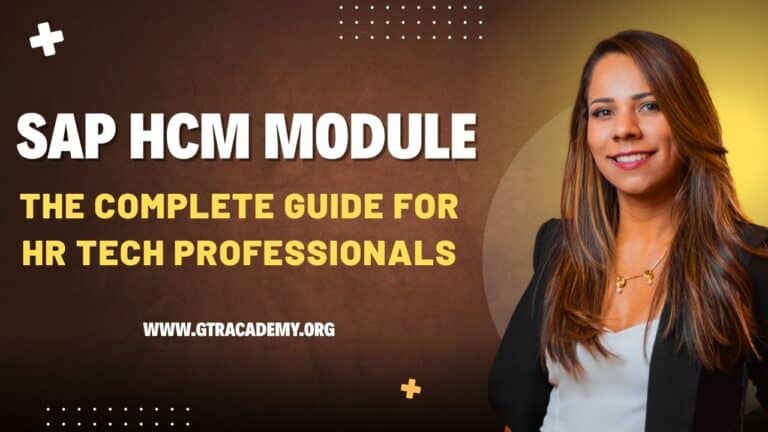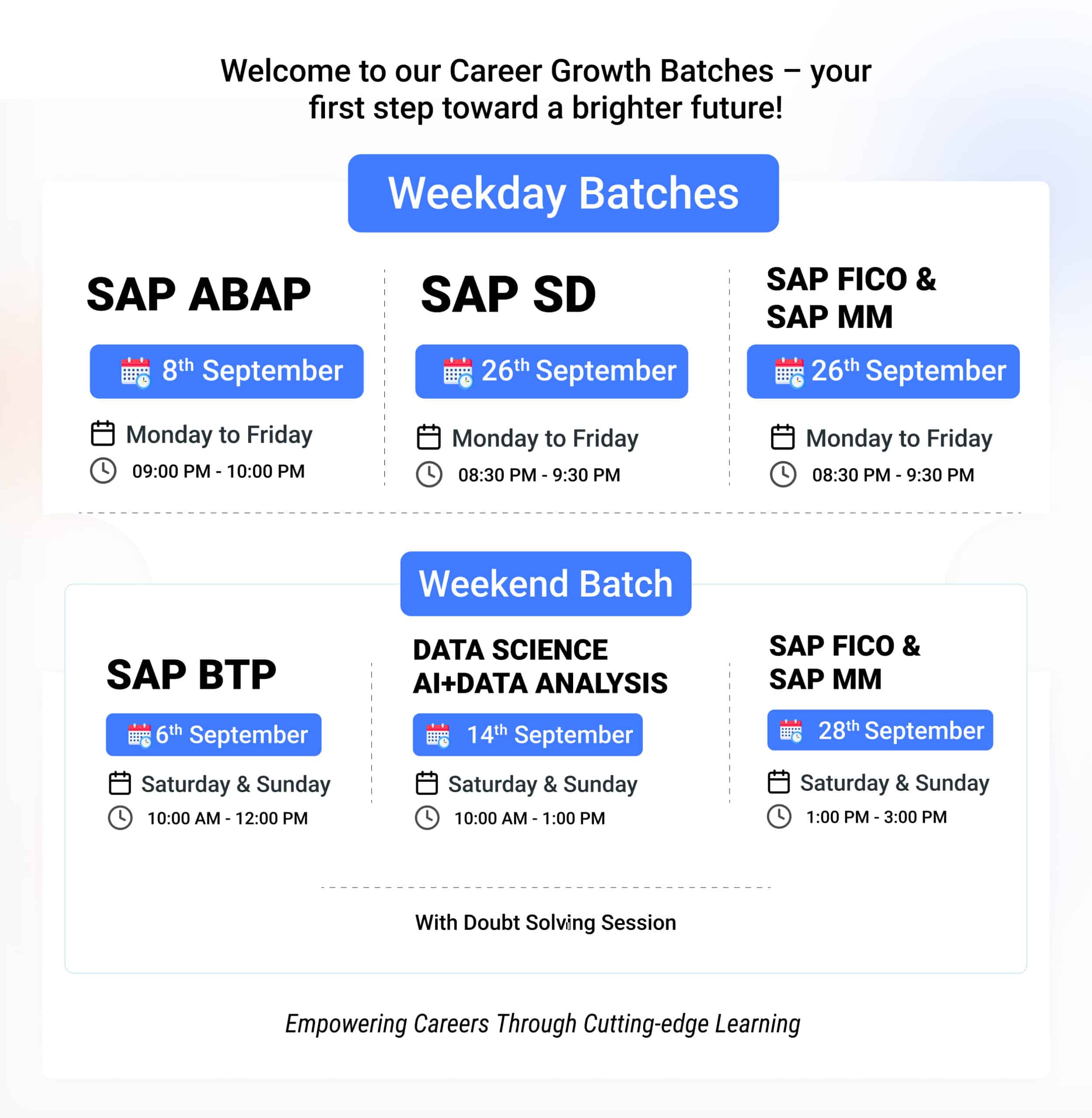The Most In-Demand SAP Module in 2025
Why SAP IBP Dominates
Introduction: The Shifting ERP Landscape
As digital transformation accelerates, businesses increasingly rely on SAP’s advanced modules to drive efficiency and competitive advantage. By 2025, SAP Integrated Business Planning (IBP) will emerge as the most sought-after module—combining AI-powered forecasting, real-time analytics, and end-to-end supply chain optimization. This article explores why IBP is becoming indispensable and what skills professionals need to master it.
1. What Makes SAP IBP the Top Module in 2025?
SAP IBP revolutionizes business planning by integrating:
✔ Demand Planning – AI-driven sales forecasting
✔ Supply Planning – Real-time inventory optimization
✔ Response & Supply Control – Agile adjustments to disruptions
✔ Inventory Optimization – Reducing waste and costs
Why the surge in demand?
-
Post-pandemic, companies need resilient, data-driven supply chains
-
Rising consumer expectations demand faster, more accurate planning
-
Sustainability regulations push firms toward waste-reducing strategies
2. Key Drivers Fueling IBP Adoption
A. The Data Analytics Revolution
-
IBP’s machine learning algorithms process vast datasets to predict demand shifts.
-
Businesses transitioning to real-time decision-making can’t rely on legacy ERP tools.
B. Digital Transformation in Core Industries
-
Manufacturing & Retail need IBP for just-in-time inventory and supply chain agility.
-
Logistics firms use IBP to optimize routes, reduce fuel costs, and improve delivery times.
C. The Sustainability Imperative
-
IBP helps companies simulate eco-friendly scenarios (e.g., lower carbon footprints).
-
Waste reduction through predictive inventory management aligns with ESG goals.
3. Why Is SAP IBP So Challenging to Master?
Unlike traditional SAP modules, IBP demands:
🔹 Technical Expertise – Configuring AI models, cloud integrations, and real-time dashboards
🔹 Business Acumen – Understanding supply chain dynamics, financial planning, and risk management
🔹 Soft Skills – Leading cross-functional teams through digital transformation
The Talent Gap:
-
Few professionals have both SAP IBP certification and strategic planning experience.
-
Universities and training programs are struggling to keep pace with industry needs.
4. Who Needs SAP IBP Skills? Career Opportunities in 2025
Professionals who master IBP can pursue high-growth roles like:
IBP Consultants – Helping firms implement and optimize IBP ($120K+ avg. salary)
Supply Chain Analysts – Using IBP to predict disruptions and streamline operations
Digital Transformation Leaders – Guiding companies through AI-driven planning shifts
Industries Hiring IBP Experts:
Manufacturing
Retail & E-Commerce
Logistics & Transportation
Energy & Utilities
5. Preparing for the IBP-Driven Future
To stay competitive, professionals should:
✅ Get Certified – SAP IBP training and cloud certifications
✅ Develop Analytical Skills – Python, SQL, and Power BI for advanced forecasting
✅ Gain Cross-Functional Experience – Work with finance, procurement, and operations teams
For Businesses:
-
Invest in upskilling teams to avoid talent shortages.
-
Start piloting IBP now to stay ahead of competitors.
Conclusion: SAP IBP as the Future of Enterprise Planning
By 2025, SAP IBP will be non-negotiable for businesses seeking agility, sustainability, and data-driven growth. Professionals who master it will lead the next wave of ERP innovation, making IBP expertise one of the most valuable skills in the job market.
The Bottom Line:
If you’re pursuing an SAP career, prioritize IBP now—it’s where the biggest opportunities (and salaries) will be.
Why This Version Works Better?
✔ Clear Headings & Subheadings – Easy to scan and digest.
✔ Data-Backed Insights – Explains why IBP matters with trends and salary figures.
✔ Actionable Advice – Tells professionals/businesses what to do next.
✔ Future-Focused – Aligns with 2025 industry shifts.
Would you like any section expanded (e.g., salary benchmarks, case studies)?
Here are the most relevant types of images to pair with your SAP IBP article, along with suggestions on where to source them:
Best Image Types for Your Content:
-
SAP IBP Dashboard Visualization
-
Shows the AI-powered planning interface with charts/forecasts
-
Example search: “SAP IBP analytics dashboard screenshot”
-
-
Supply Chain Digital Twin Concept
-
Visualizes end-to-end supply chain with data flows
-
Example: “Digital supply chain network visualization”
-
-
AI Forecasting Graphic
-
Shows machine learning predicting demand curves
-
Example: “AI demand forecasting graph”
-
-
ERP Skills Gap Infographic
-
Visual representation of SAP IBP talent shortage
-
Example: “ERP skills gap statistics infographic”
-
-
Sustainable Supply Chain Image
-
Green logistics/eco-friendly warehouse concept
-
Example: “Sustainable supply chain circular economy”
-
Recommended Free Sources (Creative Commons):
-
Wikimedia Commons (high-quality technical diagrams)
-
Pexels/Pixabay (conceptual business/tech images)
-
SAP Press Room (official module screenshots)
-
Freepik (infographic elements with attribution)
Paid Stock Options (Higher Quality):
-
Shutterstock (search “SAP IBP” or “digital supply chain”)
-
Getty Images (professional business technology visuals)
-
Adobe Stock (modern ERP concept illustrations)
Pro Tip:
For maximum relevance, look for images featuring:
-
Overlaid SAP logos/module names
-
Blue/orange SAP color scheme
-
Modern flat design with data visualization elements







